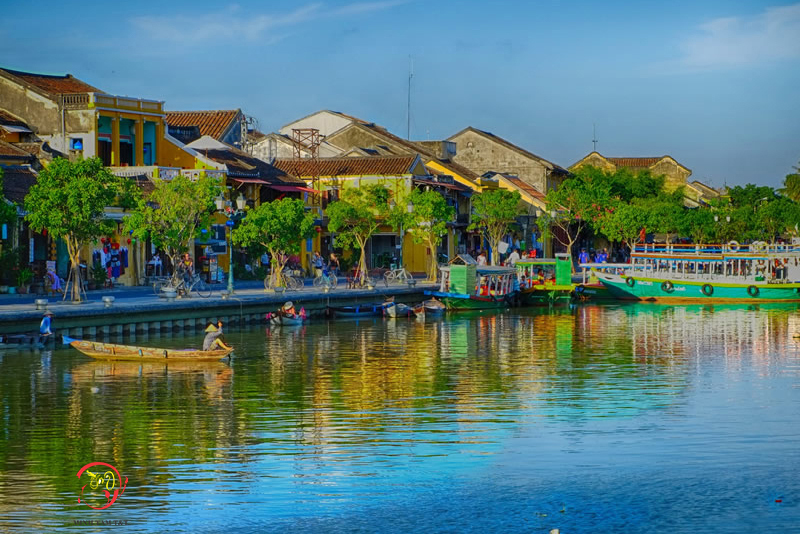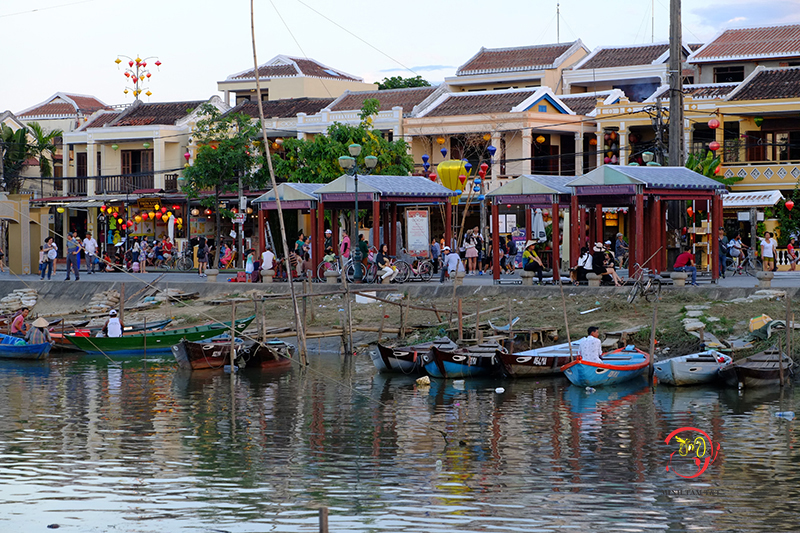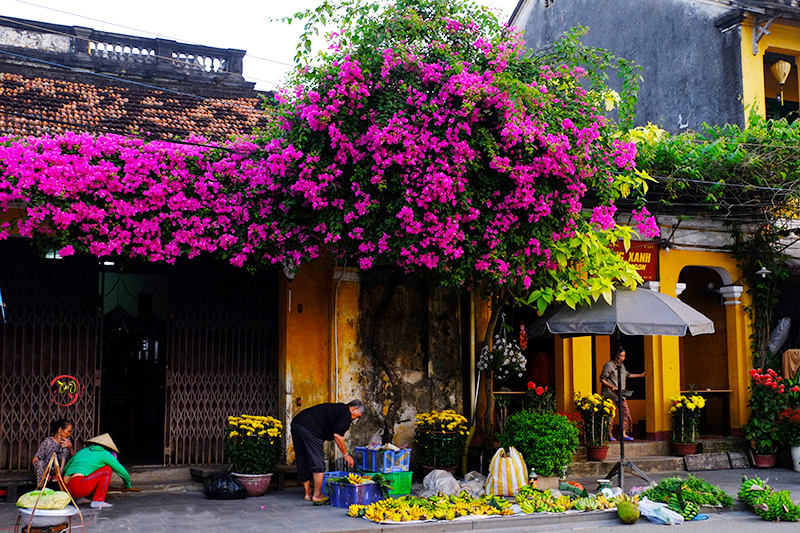1. History
Hoi An, is a land rich in traditions of revolutionary, history and culture, is collected through the ages and it used to be well-known as an international market with many different names such as Lam Ap, Faifo, Hoai Pho and Hoi An …

Due to its favorable geographical characteristics, this land had existed and developed the belated Sa Huynh culture for over 2000 years. The result of archaeological research in four burial relics (An Bang, Hau Xa I, Hau Xa II, Xuan Lam) and 5 living places (Hau Xa I, boiling, Dong Na, Thanh Chiam, Bau Da), were various types of typical burial jar with production tools, life tools, excellent stone/ ceramic/glass/ metal jewelries … were taken from the ground that asserted the flourishing period of the Sa Huynh culture. In particular, the discovery of two Chinese coins (Pentateuch, Wang Mang), the Western Han Dynasty-style iron artifacts, the shadow of Dong Son, Oc Eo culture or jewelries with refined processing technique in the excavated hole proved an interesting thing that in early AD, foreign trade was very first built in Hoi An.
Under the kingdom of Champa (9-10 century), named Lam Ap Pho, Hoi An was a port in developing which attracting merchants from Arab, Persia, China to trade and exchange goods. According to many ancient bibliographies, there was a long time that Champa port – Lam Ap Pho played an important role in creating the prosperity of Tra Kieu – the first capital of the Champa Kingdom and My Son sanctuary. With the ruins of Champa towers, wells and statues (the dancer Thien Tien Gandhara, the wealth god Kubera, the elephant god …) and pieces of Chinese ceramics, Vietnam, Middle East from the 2nd-14th century is taken up from the ground. It is demonstrated an assumption that there was a Lam Ap Pho (the Cham Pa) before Hoi An (the Dai Viet) at Champa port in its flourishing period.

Also, thanks to favorable water environment, coupled with numerous internal – external factors from the 16th century to the 19th century, urban areas – trading port of Hoi An was reborn and in thriving development. Because of the attraction of this port, along with “Silk Road”, “Ceramic road” were formed before on the waterway, merchant ships from China, Japan, India, Thailand, Portugal, Vietnam, UK, France … flocked to trade.
According to historical documents, the number of vessels entering the harbor so much crowded, the goods were diversified. During this period, Hoi An was an international commercial port flourished in most of countries and Southeast Asia, a major economic base of the Nguyen dynasty also.
From the late 19th century, influenced by many adverse factors, “Hoi An sailboat port ” gradually declined and then disappeared , leaving its historic role for ” young mechanic port” in Da Nang. But due to that, Hoi An could avoid a variation from the impact of modern urbanization to keep preserving an urban architectural ensemble unique and great till now.
During 117 years of resistance against foreign invasion (1858-1975), thousands of Hoi An people who fell down for the independence and unification of Viet Nam. Many local regions and some of Hoi An people have been awarded the title of “Hero”.

On August 22, 1998, Hoi An was awarded the title of “Hero of the People’s Armed Forces”. More than a year later on December 4, 1999, United Nations Education, Scientific and Cultural Organization has enter Hoi An’s name to the World Heritage and Cultural List on August 24, 2000, Hoi An was again awarded the title “Hero of Socialist Labor” in the renovation period.
2. Introdution
Location:
Hoi An district and town is on the lower section of the Thu Bon River system. It is in the coastal plain of Quang Nam province, just 28 km to the Southeast of Da Nang City.
Hoi An is located at latitudes 15o15’26’’ – 15o55’15’’ North and longitudes 108o17’08’’ – 108o23’10’’ East and shares its boarders with Duy Xuyen district in the South, Dien Ban district in the West and North and the Pacific ocean (the East Sea) in the East.
Climate:
The climate in Hoi An is rather mild. The annual average temperature is 25.6o, the percentage of humidity is 82%, rainfall reaches up to 2066mm and sunshine of 2158 hours.
Area and Population:
Hoi An has a total area of 6027.25 ha (60sq.km) inhabited by 81,021 people.
Major Potentials:
It is a coast of 7km with many nice beaches that are favourable for tourism development. Hoian also has a large fishing industry as well as plentiful in other sea products.. About 15km from the Cua Dai beach lies the Cham archipelago (of 1,591 ha) where there are many famous sea swallow nests (bird nests) as well as excellent natural environments suitable for the promotion of eco-tourism.
3. Monument
This assembly hall was built by Chinese overseas coming from Trieu Chau (China) in 1845. It is dedicated to the God of Wind and Big Waves.
Diep Dong Nguyen Old House
This house was built in the late 19 century. The ancestors of the owner are a U.S. trader. In particular, the interior decoration was a combination of Vietnamese, Chinese and Japanese style.
Duc An Old House
Duc An old house at 129 Tran Phu st, it isn’t overrun with travelers or souvenir sellers. Its owner, Mr Phan Ngoc Tram – a direct descendant of the founding family – claims that’s because he dislike other historic house owners, he has resisted the temptation to give over his floorspace to souvenir selling.
Bale well is one of the few old wells in Vietnam – as old as a thousand years – and still attracts the attention of the local people, who have loved, protected, respected and even worshiped it over the years.
Cam Pho Communal House
Cam Pho communal house was built rather early and restored in 1817.
Minh Huong Communal House
This communal house is considered as the religious architecture of Minh Huong People – Chinese people obtained Vietnamese citizenship in order to worship heroic ancestors.
Quan Thang is currently seen as one of the nicest ancient houses in Hoi An. It is over 150 year old and carries the architecture style of Hoa Ha, China. Throughout the years, the style as well as interior decoration of the house has been lovingly preserved. That helps us at least partly imagine the lifestyle of its generations of owners, who belonged to the merchant class in Hoi An in the past.
The small fishing town of Hoi An situated on the banks of the Thu Bon River, is a quiet place that affords its visitors ample scope for relaxation. The town’s other claim to fame is its many pagodas and shrines, one of them is the Ong Pagoda in Hoi An. The Ong Pagoda like most other pagodas in the region is a place engaged in not just a place of worship and meditation, but also a cultural hub, preserving the heritage of the land. The Ong Pagoda is also popularly called the “Chua Ong Pagoda”.
The Tran Family Home and Chapel
The Tran Family Home and Chapel, Hoi An is one of those chapels in Hoi An, Vietnam that belong to the early nineteenth century. The chapel is a reflection of Vietnamese aristocracy and it also bears cultural and traditional values in it. To the visitors, The Tran Family Home and Chapel is a famous tourist attraction. People from all over the world come to visit this chapel.
Quang Trieu (Cantonese) Assembly Hall
The Quang Trieu (Cantonese) Assembly Hall, Hoi An is one of the most famous historical buildings in Hoi An, Vietnam. Along with the historical significance, the hall is also a popular tourist attraction in the small town of Hoi An. While touring the town you must visit this Quang Trieu (Cantonese) Assembly Hall to get the pleasure of viewing this architectural heritage of Vietnam.
The Japanese Covered Bridge in Hoi An is one of the famous tourist attractions in Hoi An, Vietnam. The original Vietnamese name of this bridge is “Lai Vien Kieu”. The word can be interpreted as “Pagoda in Japan”. It is considered that the Japanese Covered Bridge, Hoi An is a possession of the Japanese community of Hoi An.
Fukian Assembly Hall (Phuc Kien)
Among the various popular assembly halls in Hoi An, Vietnam, the Fukian Assembly Hall (Phuc Kien), Hoi An is the exceptional one. Hoi An is a small town in Vietnam that is full of excitements and tourist attractions. You must visit this assembly hall to encounter an excellent work of architecture that is also considered as a heritage of historical significance.
The name Old House of Tan Ky itself suggests that the building is one of the remotest historical buildings in Hoi An. The age of the old house is approximately a couple of centuries. The old house reflects the combination of both Japanese and Chinese architectural geniuses. So while visiting the small town Hoi An, in Vietnam, you must also visit this Old House of Tan Ky to encounter great historical and cultural significance of Vietnam.
Hoi An is a beautiful town in Vietnam. While traveling in Goi An, you will get to see various beautiful historical buildings and many other tourist attractions. The Old House of Phung Hung, Hoi An is one of the most famous architectural buildings that are considered to be the cultural heritage of hoi An. Visit this ancient home in Hoi An and enjoy the old-world charm.
Trung Hoa Assembly Hall (Ngu Bang Assembly Hall) of Hoi An
Trung Hoa Assembly Hall is at 64 Tran Phu Street, right of Phuoc Kien Pagoda. Established in 1741, it was then called Duong Thuong Assembly Hall. However, many people think that it was built in the 15th century. Anyway, it is also one of the oldest assembly halls in Hoi An. It was the home of Chinese immigrants and dedicated to Thien Hau Holy Mother.
Source: http://www.hoianworldheritage.org.vn/


